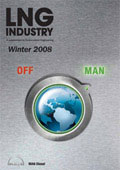Editorial comment
Cost increases and political issues have hit the LNG industry and will impact near term investment. However, overall capital expenditure (Capex) is set to reach new highs over the 2008 - 2012 period.
Register for free »
Get started now for absolutely FREE, no credit card required.
Cost increases and political issues have hit the LNG industry and will impact near term investment. However, overall capital expenditure (Capex) is set to reach new highs over the 2008 - 2012 period. A total of US$ 106 billion is projected to be spent on export terminals, LNG carriers and import (regasi?cation) terminals over the next ?ve years. These are amongst the forecasts in ‘the World LNG Market Report 2008 - 2012’ by energy analysts Douglas-Westwood.
There is an ongoing move away from the use of ‘black’ hydrocarbons (i.e. coal, oil, etc.) and towards the use of gas for power generation. LNG will play a key role in meeting growing gas demand globally. According to the EIA, natural gas is expected to account for 24% of total worldwide energy use by 2030. LNG technology offers a potential method of reducing the flaring/re-injection of ‘stranded’ natural gas reserves; those that are located a long distance from the end market, or have no nearby pipeline infrastructure. This is beneficial to the increasingly environmentally conscious countries, particularly those in West Africa, where gas flaring is a major source of pollution. LNG also allows for the economic development of large non-associated gas reserves in countries that already have enough gas production to cover domestic demand. As of this year, there are over 21 LNG liquefaction sites in 15 countries with over 60 LNG receiving terminals in 18 countries.
Offshore LNG is another major growth area. Currently there are several offshore regasification terminals in operation in North and Latin America with a number of new projects planned for the future. Although there are no offshore liquefaction terminals currently in operation, many companies are vying for the chance to design the world’s first LNG FPSO.
Liquefaction terminals and import terminals account for the largest share of the forecast spends, each representing 38% and 33% respectively. A key trend within the liquefaction terminals segment is the advancing technology that has enabled the development of larger liquefaction trains creating larger economies of scale.
Asia currently has the largest proportion of global LNG expenditure as Asian countries are involved in all aspects of the LNG chain; liquefaction, transportation (particularly the construction of new carriers) and regasification. Over the forecast period, the region accounts for 43% of the US$ 106.8 billion of our global forecast. The Middle East region is the next most significant due to its large exporting facilities, led by Qatar, and together the top two regions account for 58% of total expenditure. Meanwhile, the limits of domestic gas production in North America and Western Europe are becoming clear and gas import demands are rising. Increasingly, LNG is a method of choice in satisfying growing gas demand in these regions. Following the success of the terminals established in Nigeria and Trinidad & Tobago, the wave of new projects that have emerged demonstrate a potential for serious market growth over the next five years.
For the first time, Douglas-Westwood has segmented the projected Capex for liquefaction terminals and import terminals into key expenditure items. For liquefaction terminals, the ‘construction services’ sector accounts for the biggest percentage of total Capex (24%) and is forecast to grow from US$ 1 billion in 2007 to just under US$ 3.8 billion in 2012. ‘LNG storage tanks’ and ‘engineering and procurement services’ are the next largest sectors within this segment and are expected to collectively account for 27% of total Capex. Escalating costs of labour and raw materials and the tight contractor market have led to large increases in the cost of new EPC contracts. By 2012 many projects coming onstream have costs of over US$ 500/t of annual capacity.
The outcome of our research and market modelling shows that despite project delays, LNG remains a growth market and expenditure levels will continue to follow an upward trend during the 2008 - 2012 period.

